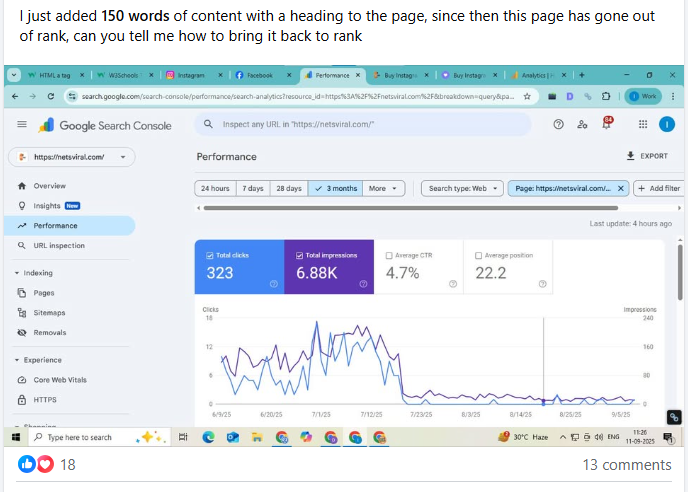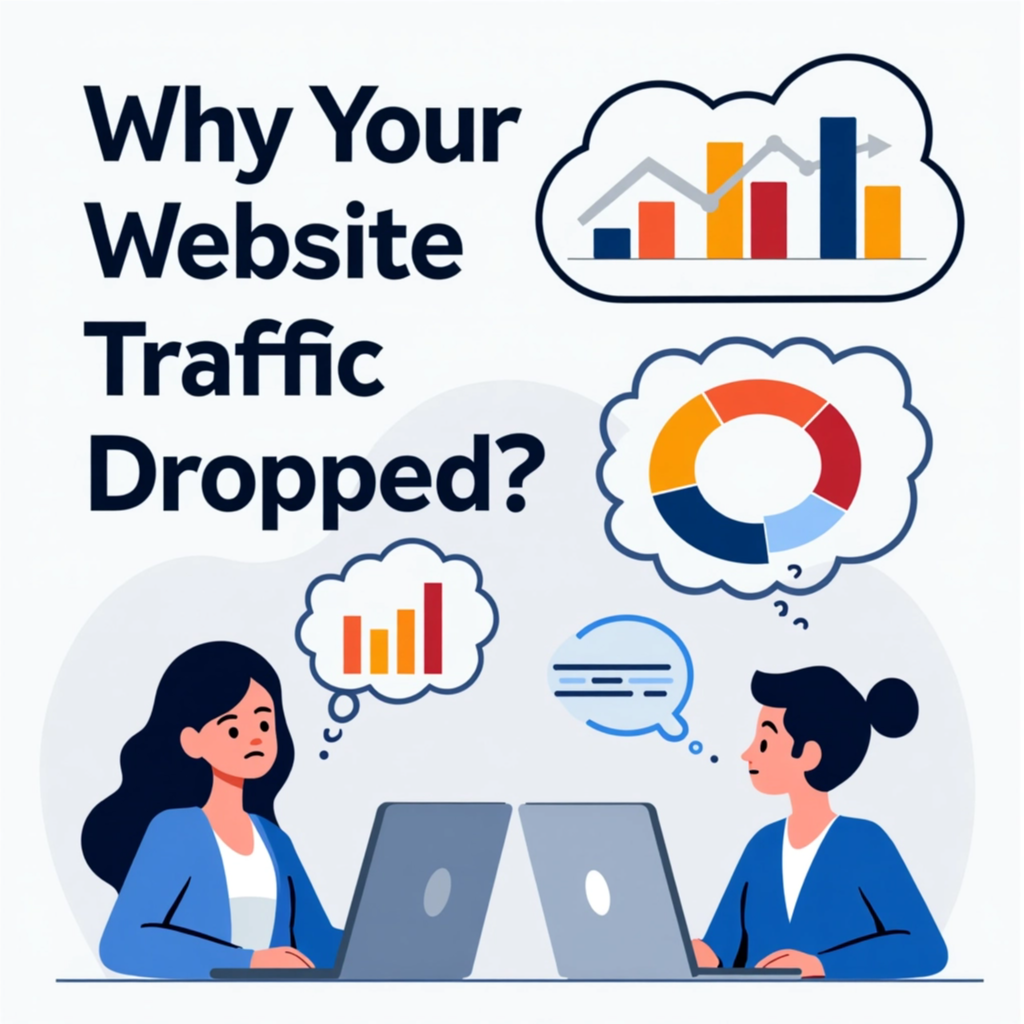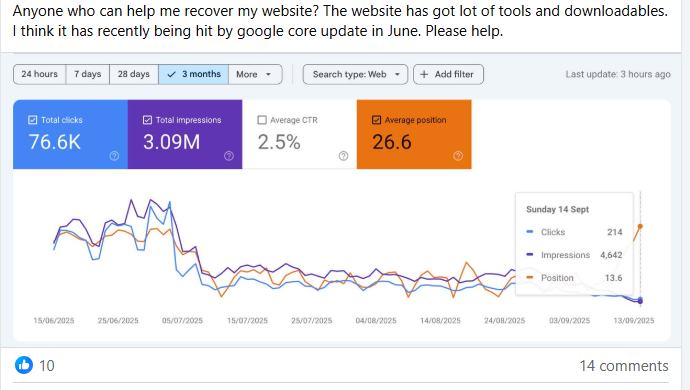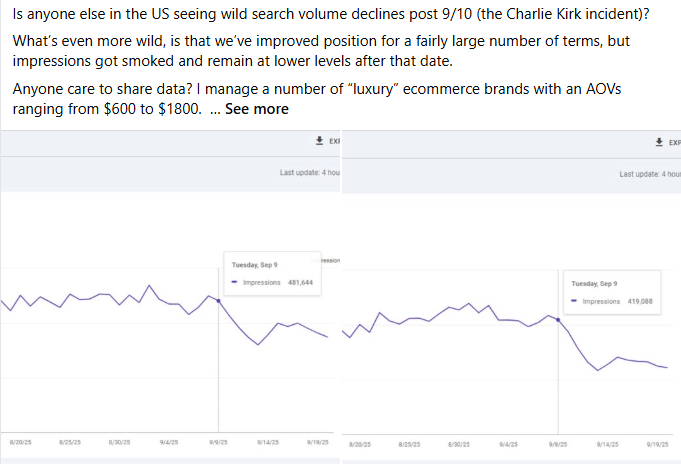⚙️ 40% of Traffic Drops Are Self-Inflicted – Did You Break Your Own Site?
If you experienced a traffic drop after changes like redesign, migration, or updates, you might have accidentally broken your SEO. The good news? Self-inflicted problems are the FASTEST to fix—often in days, not months. Here’s how to identify what broke and restore traffic immediately.
📋 Table of Contents
- How to Know If Traffic Drop After Changes Is Your Fault
- The 7 Most Common Site Changes That Cause Traffic Drop
- Traffic Drop After Changes: The Redesign Disaster
- Traffic Drop After Changes: Migration Mistakes
- Traffic Drop After Changes: Plugin & Theme Updates
- How to Diagnose Which Change Broke Your Traffic
- How to Fix Traffic Drop After Changes (Rollback vs Repair)
- Step-by-Step: Restoring Traffic After Self-Inflicted Drop
- Prevention: Never Have Traffic Drop After Changes Again
- Real Recovery Cases: Traffic Drop After Changes
- Recovery Services & Pricing
- FAQs: Traffic Drop After Changes
- Related Articles
- About the Author

Classic self-inflicted scenario: “Traffic dropped after making edits to my site”—timing proves causation
How to Know If Traffic Drop After Changes Is Your Fault
You made changes to your website. A few days later, traffic tanked. Coincidence or causation?
Here’s how to verify if your traffic drop after changes was self-inflicted:
✓ Self-Inflicted Traffic Drop Checklist
- Traffic dropped within 1-7 days after making site changes
- Google Search Console shows NO manual action penalty messages
- Rankings stayed relatively stable (didn’t drop 50%+)
- No major Google algorithm update in that timeframe
- You can document exactly what changed and when
- Drop was sudden (1-3 days), not gradual over months
- Competitors’ traffic didn’t drop at same time
- Traffic loss correlates perfectly with change timeline
If you checked 6+ boxes, your traffic drop after changes is almost certainly self-inflicted. This is actually good news—you control the fix.
The 7 Most Common Site Changes That Cause Traffic Drop

Typical analytics view of traffic drop after changes: sudden cliff starting exactly when site updated
Traffic Drop After Changes: The Redesign Disaster
Website redesigns are the #1 cause of self-inflicted traffic drop after changes. Here’s why:
What Redesigns Break:
- URL Structure: New URLs without redirects from old URLs
- Meta Tags: New theme doesn’t pull old title/description
- Schema Markup: Structured data not implemented in new theme
- Internal Linking: Navigation changed, orphaned old content
- Page Speed: New theme has bloated code, loads slowly
- Mobile Responsiveness: New design doesn’t work on mobile
- Content Loss: Developer deleted “unused” pages that had traffic
Real Case: E-commerce Redesign Gone Wrong
- Business: Fashion accessories e-commerce
- What happened: Traffic drop after changes from 89,000 to 12,000 monthly visits
- Breaking change: Shopify to custom build changed all product URLs
- Developer mistake: No 301 redirects implemented
- Google’s reaction: Lost all product pages from index
- Fix: Implemented 4,800 individual 301 redirects
- Recovery: 83% traffic back within 3 weeks
Traffic Drop After Changes: Migration Mistakes
Site migrations (hosting, platform, domain) cause traffic drop after changes when technical details are missed.
Common Migration Errors:
| Migration Type | Common Breaking Change | Impact | Fix Time |
|---|---|---|---|
| Hosting Switch | DNS propagation issues, site down 12+ hours | Google deindexes site | 2-5 days |
| HTTP → HTTPS | Forgot to redirect HTTP to HTTPS, duplicate content | Canonical confusion, 50% traffic drop | 1-2 weeks |
| Platform Change | WordPress → Webflow with no URL mapping | Lost all rankings | 3-6 weeks |
| Domain Change | Moved to new domain, old redirects incomplete | 70-90% traffic loss | 2-4 months |

Common plea after traffic drop after changes: “Need help recovering my site”—migration gone wrong
Traffic Drop After Changes: Plugin & Theme Updates
High-Risk Plugin Updates:
- SEO Plugins (Yoast, RankMath, All in One SEO): Can add no-index globally during update
- Caching Plugins (WP Rocket, W3 Total Cache): May block Googlebot from seeing fresh content
- Security Plugins (Wordfence, Sucuri): Sometimes flag Google as threat, block crawling
- Page Builders (Elementor, Divi): Updates can break schema markup or internal links
- Speed Plugins: Aggressive optimization breaks JavaScript needed for rendering
How to Diagnose Which Change Broke Your Traffic
You made 10 changes last week. Which one caused the traffic drop after changes?
Systematic Diagnostic Process
- Document all changes: List every modification made in 7 days before traffic drop—theme updates, content edits, plugin changes, settings adjustments, hosting moves
- Check Google Search Console: Coverage report shows indexing issues. URL Inspection tool reveals which pages lost indexing and why
- Test robots.txt: Visit yoursite.com/robots.txt. Look for “Disallow: /” which blocks everything. Check robots.txt tester in GSC
- Inspect meta tags: View page source. Search for “noindex”. If present, that’s your problem. SEO plugin likely added it
- Check redirects: Use HTTP Status Checker. Old URLs should 301 to new URLs, not 404
- Verify schema markup: Use Schema.org validator. Lost structured data = lost rich snippets = lower CTR
- Test page speed: PageSpeed Insights shows if new theme is slow. Under 3 seconds = good, over 5 seconds = problem
- Check internal links: Use Screaming Frog to crawl site. 404 errors mean broken navigation
Diagnostic Decision Tree:
⚙️ Which Change Caused Traffic Drop?
- If Coverage report shows “Crawled – currently not indexed”: Robots.txt or no-index problem
- If old URLs return 404 errors: Missing 301 redirects
- If page source shows “noindex” meta tag: SEO plugin misconfiguration
- If schema validator shows no markup: Lost structured data during migration
- If PageSpeed score dropped from 80+ to under 50: New theme is too slow
- If Screaming Frog shows 100+ broken links: Navigation broke during redesign

Search volume decline chart showing traffic drop after changes—clear correlation with site update date
How to Fix Traffic Drop After Changes (Rollback vs Repair)
You have two options when facing traffic drop after changes: complete rollback or targeted repair.
Option 1: Complete Rollback
- You have a complete, tested backup from before changes
- Changes were recent (within 7 days)
- Can’t identify specific breaking element
- Traffic loss exceeds 70% and revenue is critical
- New changes weren’t essential to business
Option 2: Targeted Repair
- You identified the specific breaking change
- New design/features are important to keep
- Breaking change is simple to fix (add redirects, remove no-index)
- Don’t have clean backup to restore
- Changes were made 2+ weeks ago (rollback harder)
Targeted Repair: Fix-by-Fix Guide
| Breaking Change | How to Fix | Tools Needed | Recovery Time |
|---|---|---|---|
| Missing 301 redirects | Map all old URLs to new URLs, implement redirects via .htaccess or plugin | Redirection plugin | 1-3 weeks |
| Robots.txt blocking | Remove “Disallow: /” or specific blocking rules, request re-crawl | Text editor, GSC | 2-5 days |
| No-index tags | Remove meta noindex from affected pages, force re-index via GSC | SEO plugin, GSC | 3-7 days |
| Lost schema markup | Re-implement structured data for articles, products, FAQs | Schema plugin | 1-2 weeks |
| Slow page speed | Optimize images, enable caching, minify CSS/JS, use CDN | WP Rocket, Cloudflare | 1-2 weeks |
| Broken internal links | Fix navigation, restore link structure, update menus | Screaming Frog | 1-2 weeks |
Step-by-Step: Restoring Traffic After Self-Inflicted Drop
Complete Recovery Protocol
- STOP making more changes: Freeze site development. More changes make diagnosis harder. Document everything currently broken.
- Create emergency backup: Before attempting fixes, backup current broken state. This allows safe experimentation.
- Fix critical technical issues first: Unblock robots.txt, remove no-index tags, restore site accessibility. These are quick wins.
- Implement 301 redirects: Map ALL old URLs to new destinations. Use redirect chains sparingly (old → new directly, not old → middle → new).
- Restore lost SEO elements: Re-add schema markup, ensure canonical tags present, verify meta titles/descriptions, check heading structure.
- Request immediate re-crawl: GSC URL Inspection → Request Indexing for top 20 pages. Submit updated sitemap.
- Monitor daily for 14 days: Check Google Analytics and GSC Performance report every day. Look for recovery signs (impressions returning first, then clicks).
- Expect gradual recovery: Technical fixes: 3-7 days. Redirect fixes: 1-3 weeks. Content restoration: 2-4 weeks. Don’t panic if not instant.
- Document what broke: Create “lessons learned” document. Prevents same mistakes on future changes.
- Implement change management: Never deploy major changes without staging test, backup, and monitoring plan.
Prevention: Never Have Traffic Drop After Changes Again
Pre-Change Checklist (Use Before EVERY Major Update):
✓ Mandatory Pre-Change Protocol
- Create full site backup: Database + files, test restoration works
- Test on staging server: Never deploy untested changes to live site
- Document planned changes: What’s changing, when, who made it, why
- Audit SEO elements: Export current meta tags, redirects, schema markup
- Plan 301 redirects: Map old URLs to new URLs BEFORE making changes
- Set up monitoring: Google Analytics real-time, GSC alerts, uptime monitor
- Prepare rollback plan: Know exactly how to revert if things break
- Schedule change strategically: Monday-Wednesday (not Friday!), never during peak season
- Inform stakeholders: Team knows changes happening, can watch for issues
- Post-change verification: Check top 20 pages load correctly, run GSC URL Inspection
Tools to Monitor Traffic After Changes:
- Google Analytics: Real-time report shows immediate traffic impact
- Google Search Console: Performance report shows impressions/clicks, enable email alerts
- UptimeRobot (Free): Monitors if site goes down, alerts immediately
- Screaming Frog: Crawl site before/after to compare, catch broken links
- Ahrefs Site Audit: Automated weekly scans catch SEO issues early
Real Recovery Cases: Traffic Drop After Changes
Case 1: Local Business – Accidental No-Index
- Business: HVAC repair service
- Change made: Updated SEO plugin
- Breaking change: Plugin added “noindex, nofollow” to all service pages
- Traffic drop: 88% loss (12,000 → 1,400 monthly visits)
- Diagnosis time: 15 minutes (view source showed noindex)
- Fix: Disabled plugin feature, removed tags, requested re-index
- Recovery: 92% traffic back in 5 days
Case 2: SaaS Company – Migration URL Disaster
- Business: Project management software
- Change made: WordPress to Webflow migration
- Breaking change: No URL mapping, all blog posts 404’d
- Traffic drop: 76% loss (47,000 → 11,200 monthly visits)
- Diagnosis time: 1 hour (GSC showed 404 spike)
- Fix: Created 487 individual 301 redirects
- Recovery: 81% traffic back over 19 days
Case 3: Publisher – Theme Update Speed Issue
- Business: Lifestyle blog (ad revenue model)
- Change made: Updated to new theme version
- Breaking change: Theme added heavy animations, page speed dropped from 2.1s to 8.7s
- Traffic drop: 43% loss over 2 weeks (gradual decline)
- Diagnosis time: 30 minutes (PageSpeed Insights showed issue)
- Fix: Disabled animations, optimized images, enabled caching
- Recovery: 67% traffic back over 3 weeks
Ready to Recover Your Website Traffic?
Stop losing traffic. Start recovering with proven frameworks and expert guidance.
Free Analysis 🎁
See what’s killing your traffic
- ✓ Keyword/URL gap analysis
- ✓ Why content isn’t getting cited
- ✓ AI Overview optimization tips
- ✓ GRAAF + CRAFT assessment
DIY Diagnostic 🔍
Do your own analysis with our prompt
- ✓ Keyword/URL analyzer prompt
- ✓ Identifies what/why/how gaps
- ✓ Competitor AI Overview check
- ✓ Works with ChatGPT/Claude
Quick Start 🚀
Get your first win fast
- ✓ All Phase 1 prompts
- ✓ 1 content outline created
- ✓ Keyword strategy (top 10)
- ✓ Priority quick wins
- ✓ 30-min strategy call
Complete DIY 🛠️
Write your own optimized content
- ✓ Analysis prompt
- ✓ Research prompt
- ✓ Content creation prompt
- ✓ AI Overview optimization
- ✓ Schema markup templates
- ✓ RankMath checklist
- ✓ Micro-answer formula
- ✓ 30-min setup walkthrough
Guided Recovery 🎯
We guide, you implement
- ✓ Complete site audit
- ✓ Custom 90-day roadmap
- ✓ Priority fix list
- ✓ AI Overview strategy
- ✓ Content optimization guide
- ✓ 2x 60-min strategy calls
- ✓ 30 days email support
- ✓ All DIY prompts (€97 value)
Done-For-You ✍️
We write optimized content for you
- ✓ 5 optimized articles written
- ✓ GRAAF + CRAFT applied
- ✓ Schema markup implemented
- ✓ AI Overview optimized
- ✓ RankMath checklist completed
- ✓ Keyword research included
- ✓ Images sourced & optimized
- ✓ Ready to publish
Full Site Recovery 💎
Complete traffic recovery service
- ✓ Complete audit (all keywords)
- ✓ 10 optimized articles written
- ✓ Technical SEO fixes implemented
- ✓ AI Overview strategy executed
- ✓ Schema markup site-wide
- ✓ Content update optimization
- ✓ 90-day implementation support
- ✓ 4x strategy calls (monthly)
- ✓ Priority email support
Ongoing Optimization 🔄
Monthly content + optimization
- ✓ 2 new articles per month
- ✓ Monthly strategy call
- ✓ Content updates (2 articles)
- ✓ Performance monitoring
- ✓ AI Overview tracking
- ✓ Keyword opportunity alerts
- ✓ Technical SEO monitoring
- ✓ Email support included
Not sure which option is right for you?
Talk to Us (Free Consultation) →View Full Service Details →
FAQs: Traffic Drop After Changes
Q: Should I roll back all changes or try to fix individual issues?
A: If traffic drop after changes exceeds 70% and you have clean backup, rollback is safest. If drop is 30-50% and you identified breaking element, targeted fix is faster. Rollback = 3-5 days recovery, targeted fix = 1-3 weeks.
Q: How long does traffic take to return after fixing self-inflicted issues?
A: Technical fixes (robots.txt, no-index): 2-7 days. URL redirects: 1-3 weeks. Content restoration: 2-4 weeks. Page speed fixes: 1-2 weeks. Depends on how fast Google re-crawls and re-evaluates your site after traffic drop after changes.
Q: Can developer insurance cover traffic drop after changes?
A: No. Most web development contracts disclaim responsibility for traffic loss. Always test on staging, maintain backups, and have rollback plan. Prevention is only protection against traffic drop after changes.
Q: My developer says “rankings take time to recover.” Is that true?
A: Partly. Self-inflicted technical issues recover FAST (days to weeks). But if developer actually broke fundamental SEO and didn’t fix properly, recovery takes months. Get second opinion if no improvement after 30 days of supposed “fixes.”
Q: Should I hire the same developer who broke my site to fix it?
A: Depends. If they made honest mistake and know how to fix, yes. If they don’t understand SEO and can’t explain what broke, hire SEO specialist. Many developers are good at design but weak on technical SEO for traffic drop after changes recovery.
Q: Will Google penalize me for rolling back changes?
A: No. Google doesn’t penalize legitimate rollbacks. Restoring previous working version is safest way to fix traffic drop after changes. Just ensure you redirect properly and don’t create duplicate content issues.
Related Articles
Sources & References
- Google Search Central – Site Migration Guide
- Google – Robots.txt Testing Tool
- Schema.org Structured Data Validator
- Google PageSpeed Insights
- Screaming Frog SEO Spider
- Ahrefs Blog – Technical SEO
- Moz Blog – SEO Best Practices
- Case studies from 200+ ContentScale.site self-inflicted recovery projects (2022-2025)
Last Updated: October 2025 | Return to Traffic Drop Recovery Hub
